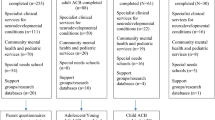Abstract
To clarify the nature of compulsive behavior in autism, staff reports of behavioral patterns of 17 young autistic adults living in a farmstead residential facility were analyzed. Three staff members who had worked most closely with each resident for at least 3 months completed three questionnaires, including Quantitative and Qualitative compulsive behavior scales, and the Childhood Autism Rating Scale (CARS). The questionnaires were completed on two occasions with a 2-week interval between administrations. Test-retest and interrater consistencies were examined for each of the scales. Both the Qualitative and Quantitative questionnaires show promise as instruments that could be used as objective baselines or descriptors for compulsive behavior in autism. Information gathered from these scales could be utilized to determine how to intervene in the behavior, and to assess progress in treatment programs.
Similar content being viewed by others
References
American Psychiatric Association. (1987).Diagnostic and statistical manual of mental disorders. (3rd ed., rev.). Washington, DC: Author.
Beech, H. R. (1971). Ritualistic activity in obsessional patients.Journal of Psychosomatic Research, 15, 417–422.
Berkson, G. (1983). Repetitive stereotyped behaviors.American Journal of Mental Deficiency, 88, 239–246.
Campbell, M., Locascio, J. J., Choroco, M. C., Spencer, E. K., Malone, R. P., Kafantaris, V., & Overall, J. E. (1990). Stereotypies and tardive dyskinesia: Abnormal movements in autistic children.Psychopharmacology Bulletin, 26, 260–266.
Cook, E. H., Rowlett, R., Jaselskis, C., & Leventhal, B. L. (1992). Fluoxetine treatment of children and adults with autistic disorder and mental retardation.Journal of the American Academy of Child and Adolescent Psychiatry, 31, 739–745.
DeSeixas Queiroz, L. O., Motta, M. A., Madi, M. B., Sossai, D. L., & Boren, J. J. (1981). A functional analysis of obsessive-compulsive problems with related therapeutic procedures.Behavior Research Therapy, 19, 377–388.
Gordon, C. T., State, R. C., Nelson, J. E., Hamburger, S. D., & Rapoport, J. L. (1993). A double-blind comparison of clomipramine, desipramine, and placebo in the treatment of autistic disorder.Archives of General Psychiatry, 50, 441–447.
Hiss, H., & Kozak, M. J. (1991). Exposure treatment of obsessive-compulsive disorder in the mentally retarded.Behavior Therapist, 101, 163–167.
Insel, T. R., & Akiskal, H. S. (1986). Obsessive-compulsive disorder with psychotic features: A phenomenologic analysis.American Journal of Psychiatry, 143, 1527–1533.
Iwata, B. A., Dorsey, M. F., Slifer, K. J., Bauman, K. E., & Richman, G. S. (1982). Toward a functional analysis of self-injury.Analysis and Intervention in Developmental Disabilities, 2, 3–20.
Jenike, M. A. (1990a). Drug treatment of obsessive-compulsive disorder. In M. A. Jenike & L. A. Baer (Eds.),Obsessive Compulsive Disorders: Theory and Management (pp. 249–282). Chicago: Yearbooks Medical Publishing.
Jenike, M. A. (1990b). Theories of etiology. In M. A. Jenike & L. A. Baer (Eds.), Obsessive Compulsive Disorders. Theory and Management (pp. 99–117). Chicago: Yearbook Medical Publishing.
Kanner, L. (1943). Autistic disturbances of affective contact.Nervous Child, 2, 217–250.
Kay, B. R. (1990). Bittersweet farms.Journal of Autism and Developmental Disorders, 20, 309–321.
Maurer, R. G., & Damasio, A. R. (1982). Childhood autism from the point of view of behavioral neurology.Journal of Autism and Developmental Disorders, 12, 195–205.
McDougle, C. J., Price, L. H., & Goodman, W. K. (1990). Fluvoxamine treatment of autistic disorder and obsessive-compulsive disorder: A case report.Journal of Autism and Developmental Disorders, 20, 537–543.
McDougle, C. J., Price, L. H., Volkmar, F. R., Goodman, W. K., Ward-O'Brien, D., Nielsen, J., Bregman, J., & Cohen, D. J. (1992). Clomipramine in autism: Preliminary evidence of efficacy.Journal of the American Academy of Child and Adolescent Psychiatry, 31, 746–750.
Mehlinger, R., Scheftner, W. A., & Poznanski, E. (1990). Fluoxetine and autism.Journal of the American Academy of Child and Adolescent Psychiatry, 29, 985.
Michael, J. (1982). Distinguishing between discriminative and motivational functions of stimuli.Journal of Experimental Analysis of Behavior, 37, 149–155.
Ollendick, T. H., & Ollendick, D. G. (1982). Anxiety disorders. In J. L. Matson & R. R. Barrett (Eds.),Psychopathology in the mentally retarded (pp. 77–120). New York: Grune & Stratton.
Rachman, S. J., & Hodgson, R. J. (1980).Obsessions and compulsions. Englewood Cliffs, NJ: Prentice-Hall.
Reid, A. H. (1985). Psychiatric disorders. In A. M. Clarke & J. M. Berg (Eds.),Mental deficiency: The changing outlook. New York: Free Press.
Rumsey, J. M., Rapoport, J. L., & Sceery, W. R. (1985). Autistic children as adults: Psychiatric, social, and behavioral outcomes.Journal of the American Academy of Child Psychiatry, 24, 465–473.
Schopler, E., Reichler, R. J., DeVellis, R. F., & Daly, K. (1980). Toward objective classification of childhood autism: Childhood autism rating scale (CARS).Journal of Autism and Developmental Disorders, 10, 91–103.
Sevin, J. A., Matson, J. L., Coe, D. A., Fee, V. E., & Sevin, B. M. (1991). A comparison and evaluation of three commonly used autism scales.Journal of Autism and Developmental Disorders, 21, 417–432.
Simons, J. M. (1974). Observations on compulsive behavior in autism.Journal of Autism and Childhood Schizophrenia, 4, 1–10.
Victor, G. (1983).The riddle of autism. Lexington, MA: Lexington Books.
Vitiello, B., Spreat, S., & Behar, D. (1989). Obsessive-compulsive disorder in mentally retarded patients.Journal of Nervous and Mental Disease, 177, 232–236.
Author information
Authors and Affiliations
Additional information
The authors thank the staff and residents of Bittersweet Farms for their assistance in completing this project. Sincere gratitude is extended to Charlie Flowers and Vicki Obee for their support in making this study possible.
Rights and permissions
About this article
Cite this article
McBride, J.A., Panksepp, J. An examination of the phenomenology and the reliability of ratings of compulsive behavior in autism. J Autism Dev Disord 25, 381–396 (1995). https://doi.org/10.1007/BF02179374
Issue Date:
DOI: https://doi.org/10.1007/BF02179374



